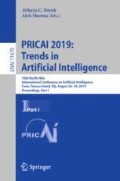Abstract
This study solves the problem of unknown(UNK) word in machine translation of agglutinative language in two ways. (1) a multi-granularity preprocessing based on morphological segmentation is used for the input of generative adversarial net. (2) a filtering mechanism is further used to identify the most suitable granularity for the current input sequence. The experimental results show that our approach has achieved significant improvement in the two representative agglutinative language machine translation tasks, including Mongolian\(\rightarrow \)Chinese and Japanese\(\rightarrow \)English.
Access this chapter
Tax calculation will be finalised at checkout
Purchases are for personal use only
References
Chen, X., Sun, Y., et al.: Adversarial deep averaging networks for cross-lingual sentiment classification. In: Association for Computational Linguistics (ACL), pp. 557–570 (2016)
Gehring, J., Auli, M., Grangier, D., et al.: Convolutional sequence to sequence learning. In: International Conference on Machine Learning (ICML), pp. 1243–1252 (2017)
Mikolov, T., Kombrink, S., Burget, L., et al.: Extensions of recurrent neural network language model. In: International Conference on Acoustics, Speech, and Signal Processing, pp. 5528–5531 (2011)
Nogueira, R., Cho, K.: Webnav: a new large-scale task for natural language based sequential decision making. arXiv preprint arXiv:1602.02261 (2016)
Papineni, K., Roukos, S., Ward, T., Zhu, W.J.: BLEU: a method for automatic evaluation of machine translation. In: Proceedings of the 40th Annual Meeting on Association for Computational Linguistics (ACL), pp. 311–318 (2002)
Ranzato, M., Chopra, S., et al.: Sequence level training with recurrent neural networks. arXiv:1511.06732 (2015)
Sunmola, F.T., Wyatt, J.L.: Model transfer for Markov decision tasks via parameter matching. In: PlanSIG 2006, pp. 246–252 (2006)
Sutskever, I., Vinyals, O., Le, Q.V.: Sequence to sequence learning with neural networks. In: Conference and Workshop on Neural Information Processing Systems (NIPS), pp. 3104–3112 (2014)
Vaswani, A., Shazeer, N., et al.: Attention is all you need. In: Conference and Workshop on Neural Information Processing Systems (NIPS), pp. 5998–6008 (2017)
Volodymyr, M., Koray, K., et al.: Human-level control through deep reinforcement learning. Nature 518(7540), 529 (2015)
Yu, L., Zhang, W., Wang, J., Yu, Y.: SeqGAN: sequence generative adversarial nets with policy gradient. In: The Association for the Advancement of Artificial Intelligence (AAAI), pp. 2852–2858 (2016)
Zhang, Y., Barzilay, R., Jaakkola, T.: Aspect-augmented adversarial networks for domain adaptation. Trans. Assoc. Comput. Linguist. 5(1), 515–528 (2017)
Zhen, Y., Wei, C., Feng, W., Bo, X.: Improving neural machine translation with conditional sequence generative adversarial nets. In: The North American Chapter of the Association for Computational Linguistics (NAACL), pp. 1346–1355 (2018)
Zhu, J.Y., Park, T., et al.: Unpaired image-to-image translation using cycle-consistent adversarial networks. In: IEEE International Conference on Computer Vision (ICCV), pp. 2223–2232 (2017)
Author information
Authors and Affiliations
Corresponding author
Editor information
Editors and Affiliations
Rights and permissions
Copyright information
© 2019 Springer Nature Switzerland AG
About this paper
Cite this paper
Ji, Y., Hou, H., Chen, J., Wu, N. (2019). Noise-Based Adversarial Training for Enhancing Agglutinative Neural Machine Translation. In: Nayak, A., Sharma, A. (eds) PRICAI 2019: Trends in Artificial Intelligence. PRICAI 2019. Lecture Notes in Computer Science(), vol 11670. Springer, Cham. https://doi.org/10.1007/978-3-030-29908-8_31
Download citation
DOI: https://doi.org/10.1007/978-3-030-29908-8_31
Published:
Publisher Name: Springer, Cham
Print ISBN: 978-3-030-29907-1
Online ISBN: 978-3-030-29908-8
eBook Packages: Computer ScienceComputer Science (R0)

